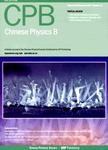Experimental research on the feature of an x-ray Talbot–Lau interferometer versus tube accelerating voltage
Experimental research on the feature of an x-ray Talbot–Lau interferometer versus tube accelerating voltage作者机构:National Synchrotron Radiation LaboratoryUniversity of Science and Technology of China Institute of Multidisciplinary Research for Advanced MaterialsTohoku University Institute of High Energy PhysicsChinese Academy of Sciences
出 版 物:《Chinese Physics B》 (中国物理B(英文版))
年 卷 期:2015年第24卷第6期
页 面:673-678页
核心收录:
学科分类:070207[理学-光学] 07[理学] 08[工学] 0803[工学-光学工程] 0702[理学-物理学]
基 金:Project supported by the Major State Basic Research Development Program of China(Grant No.2012CB825800) the Science Fund for Creative Research Groups,China(Grant No.11321503) the National Natural Science Foundation of China(Grant Nos.11179004,10979055,11205189,and 11205157) the Japan–Asia Youth Exchange Program in Science(SAKURA Exchange Program in Science)Administered by the Japan Science and Technology Agency
主 题:x-ray Talbot-Lau interferometer x-ray imaging phase-contrast tube accelerating voltage x-ray tube
摘 要:X-ray Talbot-Lau interferometer has been used most widely to perform x-ray phase-contrast imaging with a con- ventional low-brilliance x-ray source, and it yields high-sensitivity phase and dark-field images of samples producing low absorption contrast, thus beating tremendous potential for future clinical diagnosis. In this work, by changing the accel- erating voltage of the x-ray tube from 35 kV to 45 kV, x-ray phase-contrast imaging of a test sample is performed at each integer value of the accelerating voltage to investigate the characteristic of an x-ray Talbot-Lau interferometer (located in the Institute of Multidisciplinary Research for Advanced Materials, Tohoku University, Japan) versus tube voltage. Ex- perimental results and data analysis show that within a range this x-ray Talbot-Lau interferometer is not sensitive to the accelerating voltage of the tube with a constant fringe visibility of ~ 44%. This x-ray Talbot-Lau interferometer research demonstrates the feasibility of a new dual energy phase-contrast x-ray imaging strategy and the possibility to collect a refraction spectrum.



